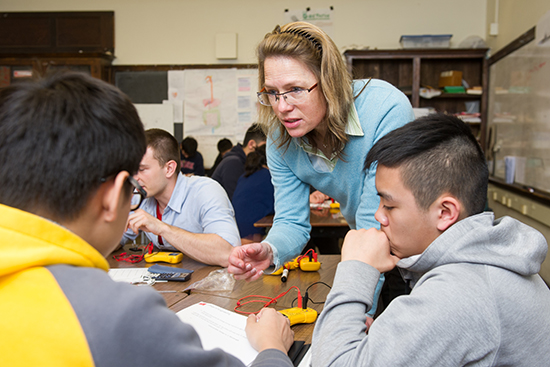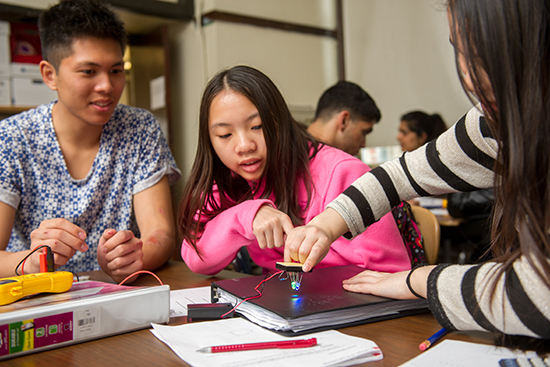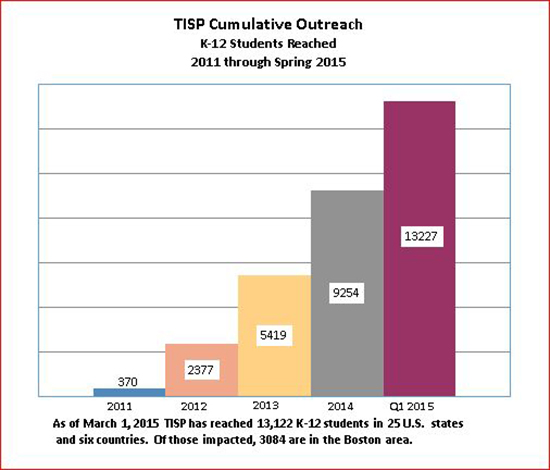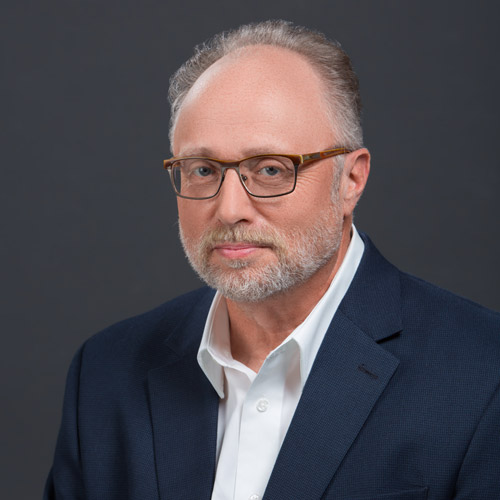Sharing the Field’s Allure
ENG brings engineering to schools to bring students to engineering

Josiah Quincy Upper School students and Gretchen Fougere, ENG associate dean for outreach and diversity, who says ENG’s goal is “to broaden and build the pipeline from K-12 schools into engineering.” Photos by Cydney Scott
It’s a warm spring morning at the Josiah Quincy Upper School in downtown Boston, and the two dozen ninth-graders entering Mr. Warner’s classroom reluctantly remove their earbuds and set down their iced coffees. Their faces seem to say: Light waves? What could be interesting about light waves?
But then the 10 College of Engineering undergraduate “Inspiration Ambassadors” scattered around the room introduce the teens to their own 9-volt batteries, circuit boards, LEDs, and voltmeters. Working in pairs, the Quincy School students must connect their LEDs to batteries, measure the voltages that create blue, red, green, and orange light, and match that to the longest and shortest wavelengths. From that, they will see firsthand Planck’s Law, which says energy and wavelength are inversely proportionate. Suddenly the room is full of cheers, groans, and urgent questions.
Hands-on makes all the difference.
It’s a small step toward ENG’s strategic goal “to broaden and build the pipeline from K-12 schools into engineering,” says Gretchen Fougere, ENG associate dean for outreach and diversity. “It’s important that we not let talent go to waste in underrepresented groups such as women and minorities. We need everybody who’s capable and interested in becoming an engineer to be ready and able to do that.”
The Technology Innovation Scholars Program (TISP), founded by Fougere in 2011, sends ENG undergrads into classrooms as Inspiration Ambassadors to get middle and high school students excited about science and to open their minds to the field as a possible career. Many, as at the Quincy School, are African American or Hispanic, and girls make up roughly half the students.
“All of the kids get super-excited because they don’t realize the potential they have,” says Inspiration Ambassador Alyssa Liem (ENG’16), who studies mechanical engineering. “When they have the ability to do something creative, to make their own code or make their own design, they see: I can do this. That’s the best thing we can provide for them—the confidence.”
Fougere has so far overseen several TISP outreach programs. One, which reached 3,000 students this year alone, sends ENG undergrads back to their high schools or middle schools all around the country during the midyear break to spread the engineering gospel. In another they mentor the FIRST (For Inspiration & Recognition of Science & Technology) robotics teams at various Boston area schools. The mission of the nonprofit FIRST, founded by Dean Kamen (Hon.’06), is to inspire young people to be science and technology leaders. Partner organizations, including AT&T, NASA, Accenture, Ametek, and the Ingalls Foundation, help fund the TISP program and have also hired numerous engineers from among the Ambassadors.

In the Quincy School program, funded by a $145,000 grant from AT&T, the ENG undergraduates work with two classes over two years, testing and debriefing students at the end of each year to quantify the program’s effect. The overarching plan is to spread BU’s TISP model to universities and colleges around the country.
Among the engineering challenges put to the Quincy students in the first year were assembling and testing their own fuel cells, building wind turbines to generate energy, and communicating by fiber optics. “I didn’t know any of this stuff beforehand,” says ninth grader Evan Chen. “Now I know a little more about engineering, what they’re doing.”
The Quincy students enjoy projects like making a wind turbine most, because they’re actually building something, says Liem. Working with their hands is a lot more exciting than hearing someone lecture. “It became a competition of how much voltage they could get from their wind turbine, redesigning and redesigning until they finally got what satisfied them,” she says.
“Sometimes time runs out and they’re still trying to redesign and begging for just one more try,” says Russell Thompson (ENG’16). “That’s fun.”
It also does a lot for the Inspiration Ambassadors, who are well aware that their chosen field skews white and male.
“I’ve always wanted to increase the diversity in engineering, because I don’t feel like we have a lot of minorities or a lot of women,” says biomedical engineering major Lidia De Barros (ENG’17), who is originally from Cape Verde. “I felt like this would give me an opportunity to reach the actual demographic of Boston, not just those who have an opportunity to come to BU, and reach out to everyone at once.”
Half of the ENG students applying to the TISP program are female and a quarter of them are underrepresented minorities, and these rates are two to three times higher than the ENG student population. About 100 undergraduates apply for the program each year, twice as many as Fougere can take.
De Barros and others say the program also helps them develop leadership skills that will be useful after they graduate, from coordinating a diverse group to learning to communicate science concepts at a level that anyone can understand—something that could be useful later in dealing with business clients. “Engineers need to be able not only to create stuff, but to understand what it means to society,” Fougere says.

TISP may be even more meaningful for students like Thompson, who is in the five-year STEM Educator-Engineer Program (STEEP), a partnership between ENG and the School of Education. STEEP students earn a bachelor’s in an engineering discipline and a master’s in teaching, equipping them to teach the STEM fields (science, technology, engineering, and math) in middle schools and high schools across the country.
The success of TISP is exemplified by Rahat Khan (ENG’17), whose first connection with the program was as a 10th-grader at the John D. O’Bryant School of Mathematics and Science in Roxbury, when TISP students began mentoring his FIRST robotics team.
“It sort of gives you a sense of connection that you don’t necessarily get with a teacher,” says Khan, who even then knew he wanted to study engineering. “In high school, you might have a notion of what mechanical engineering might be, but it’s not the same as you envision it to be. Talking with the ENG students helped me understand what each of the engineering fields actually is.”
Now Khan is studying mechanical engineering at ENG on a BU Community Service Award scholarship and is a TISP Inspiration Ambassador. He has returned to speak to middle-schoolers at the O’Bryant School over winter break and is leading four other ambassadors in mentoring FIRST robotics students at the Academy of the Pacific Rim Charter Public School in Hyde Park for a second year.
“It feels very rewarding when you see that the students are finally getting results and understanding what they’re doing,” he says. “It’s even more rewarding when some of them show interest in engineering. And even if they don’t, it feels like an accomplishment.”

Comments & Discussion
Boston University moderates comments to facilitate an informed, substantive, civil conversation. Abusive, profane, self-promotional, misleading, incoherent or off-topic comments will be rejected. Moderators are staffed during regular business hours (EST) and can only accept comments written in English. Statistics or facts must include a citation or a link to the citation.